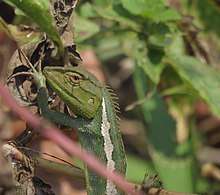Calotes jerdoni
Calotes jerdoni, commonly known as the Indo-Chinese forest lizard or Jerdon's forest lizard, is a species of lizard in the family Agamidae. The species is endemic to China and South Asia.
| Calotes jerdoni | |
|---|---|
 | |
| Scientific classification | |
| Kingdom: | Animalia |
| Phylum: | Chordata |
| Class: | Reptilia |
| Order: | Squamata |
| Suborder: | Iguania |
| Family: | Agamidae |
| Genus: | Calotes |
| Species: | C. jerdoni |
| Binomial name | |
| Calotes jerdoni | |
Etymology
The specific name, jerdoni, is in honor of British biologist Thomas C. Jerdon.[2]
Description/Identification
Physical Structure: A compressed-bodied lizard. This species resembles Calotes maria in pholidostic (scale) and other characters except that it has 45-57 scales round the body; gular scales much larger than the ventral scales; there is an oblique curved fold covered with small granular scales in front of the shoulders; nuchal crest less prominent; the hind-limb reaches to the eye or not quite so far.[3] Dorsal and lateral scales directed upward.
Color Pattern: Deep-green dorsal coloration with yellow, orange or brown spots, but in many cases can make the body into a dark brown within a few seconds.
Length: Maximum total length (including tail): 38.5 cm (15.2 in).[3] Common total length: 32 cm (13 in). Common snout-to-vent length (SVL) : 9 cm (3.5 in).
Maximum published weight: ? g.
Distribution
Bangladesh, Bhutan, China (W Yunnan, Xizang = Tibet), India (Khasi Hills in Assam & Shillong) and Myanmar.
Vernacular names
Bengali: সবুজ গিরিগিটি (Sabuj girigiti), সবুজ রক্তচোষা।
Bhutanese: tsitsimarm
Burmese: ?
Chinese: ?
English: Green forest lizard, Green garden lizard, Indo-Chinese forest lizard and Jerdon's forest lizard.
Hindi & Assamese: ?
Habit & Habitat
Terrestrial & arboreal; diurnal;[3] found in many types of forested land. Prefers dense and bushy hill forest.[4] A skillful and an adept climber, it moves over trees and bushes rather swiftly. It is active during the day time.[4]
Diet
Insectivorous; feeds largely on insects but at times bird-eggs, nestlings, and frogs too are eaten up.[4]
Reproduction
Oviparous; breeding season begins around April when males develop bright coloration in the forebody and begin to chase females. Female digs a small hollow in soft earth and lays 11-23 eggs in it for incubation and safety.[4]
Uses
No known practical uses. Play rolls in ecosystem by eating various types of insects and otherwise.
Threat to humans
Non-venomous and completely harmless to humans.
IUCN threat status
Not Evaluated (NE).
References
- Calotes jerdoni. The Reptile Database. www.reptile-database.org.
- Beolens, Bo; Watkins, Michael; Grayson, Michael (2011). The Eponym Dictionary of Reptiles. Baltimore: Johns Hopkins University Press. xiii + 296 pp. ISBN 978-1-4214-0135-5. (Calotes jerdoni, p. 134).
- http://faunaofindia.nic.in/PDFVolumes/hpg/007/index.pdf
- "Archived copy" (PDF). Archived from the original (PDF) on 2018-09-21. Retrieved 2015-10-26.CS1 maint: archived copy as title (link)
Further reading
- Annandale N (1905). "Contributions to Oriental Herpetology. Suppl. II. Notes on the Oriental lizards in the Indian Museum, with a list of the species recorded from British India and Ceylon". J. Proc. Asiatic Soc. Bengal 1 (2): 81–93.
- Günther A (1870). "Descriptions of a New Indian Lizard of the Genus Calotes ". Proc. Zool. Soc. London 1870: 778-779 + Plate XLV. (Calotes jerdoni, new species).